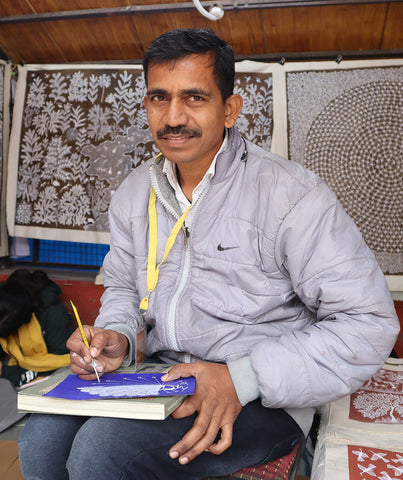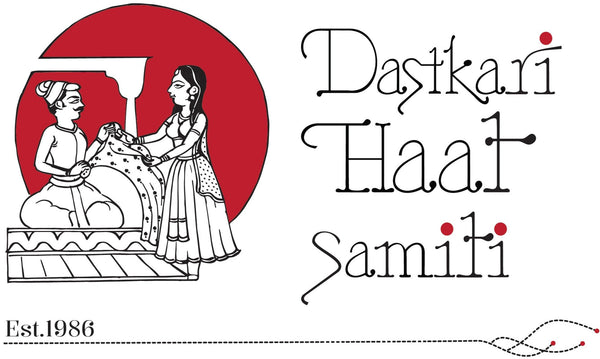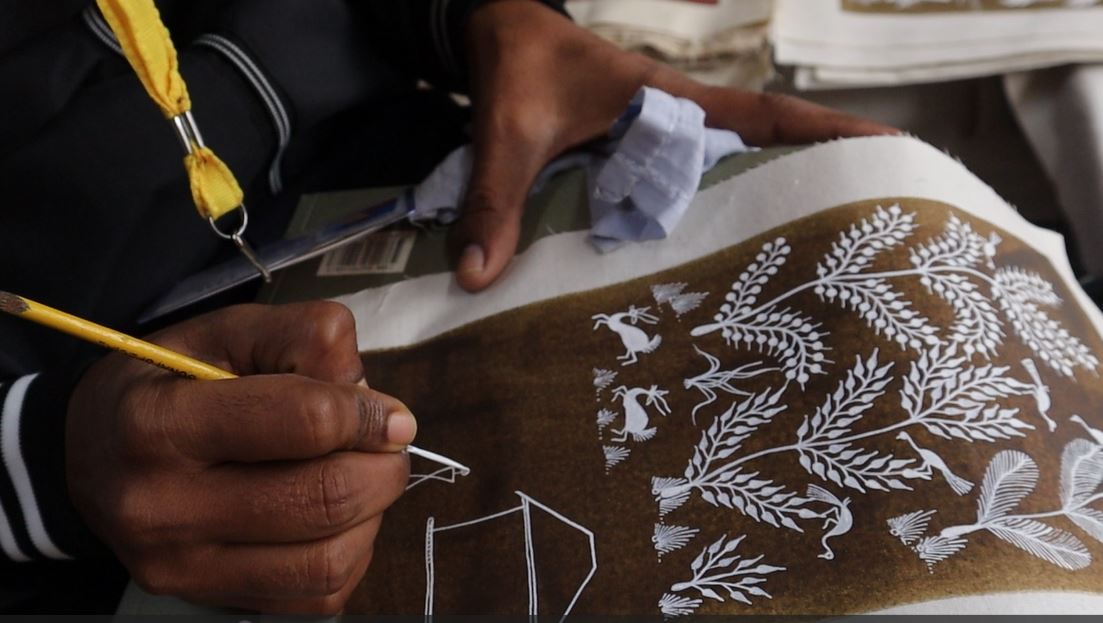The enduring legacy of Warli
The rhythmic beats of the traditional wooden clapper, the Khartal, permeated through the brisk winds of the January morning, accompanied by the melodious notes of thumris sung by a group of Bhopas. Waiting for the cold to subside, sat two Kalbeliya performers with them, soaking in the music until their turn arrived to perform.
Within minutes visitors started flocking in assessing the various stalls, recognizing the newfound artisanal products and the immemorial crafts.

Naresh Shankar Bhoye, Warli Artist
In one such stall sat a man engrossed in his art. With systematic brush strokes and undefined concentration, he proceeded to bring his imagination onto paper. On the walls of the stall hung Warli tribal art, the contrast of simplicity in forms and details in elements starkly evident. Hailing from the village Kurze Dhamodpada, Maharashtra, Mr. Naresh Shankar Bhoye could be seen deftly making geometric figures of the revered tribal art. One could infer from the paintings that they took inspiration from nature, given the depiction of foliage and wildlife. When asked to narrate tales of his art and life, eyes still glued to his work, he shyly agreed.

Wildlife and foliage are pivotal elements of the traditional art
The Warli culture worships mother nature for it provides the tribe with life’s necessities, proving to be an integral way of life. “Farming is our major source of food and fare. We pursue painting from October to February and resume kheti from March until June. While farming provides us with sustenance, our art serves as a means of subsistence.”

Depiction of a village scene
The red ochre clay walls of homes become the canvas for the art, becoming expressions of everyday life and social events of the largest tribe in Maharashtra state. After applying layers of cow dung and soil, the surface becomes ready for painting with rice flour paste. It takes four to five years for the paste to wear off, provided it's not manhandled and touched, he further informs. Taking inspiration and lessons from the senior artists of the neighboring villages in Palghar, he emerged as the first within his family to embrace the art as a livelihood. "For the past twenty-five years, I've dedicated myself to mastering this craft." he reflected. "I’ve noticed a significant growth in terms of skill and dexterity. What truly distinguishes Warli art is its innate spontaneity. Upon clutching the brush, a myriad of scenes unfold, blending the essence of surroundings and imagination onto the canvas of paper.” Usually done on dark-coloured surfaces, market demands have now led it to be done on handmade paper using acrylic as well.
He recalls how neighbors often help each other in painting the walls, making it a good past time. Previously commemorated on occasions like marriage ceremonies and Diwali, it saw its commercialization some fifty years ago, when it was recognized in the 1970s.
“Wedding is one such occasion wherein Warli art plays an essential role,” he remarked, picking one of his paintings and pointing towards a square-like structure. “This is called a Chowk,” he continued. "A marriage cannot take place in its absence. Believed to be sacred, it is drawn on the wall of the house by ‘Savasinis’ (women whose husbands are alive) where the wedding is to take place.”

Chowk, an essential part of the marriage procession
As his fingers trace the four borders of the Chowk, Naresh Ji explains how they represent the ‘Kul devatas’ or the clan deities. Within it sat the Palghat Devi or goddess of fertility. “It’s said that Palghat Devi, also known as Anaj Devi, blesses the bride and the groom with growth and prosperity. It can be said that the sun and moon drawn here commemorate the cycle of day and night, symbolizing the eternal rhythm of life which the couple would spend together, hence blessing their union."
Other elements that shone prominently within the Chowk were a comb and a ladder. “Well you see that grains and harvest are often stored in the attic, hence a ladder depicts the way to the attic- a metaphor for everlasting prosperity. As for the comb, it depicts beauty and vitality to the couple. After ritual installation, the deity's abode is veiled with a cloth to be revealed during marriage ceremonies for the deity's blessings. The paintings are believed to invoke the gods' powers.”
It's fascinating to observe how a culture's art carries with it such reverence and sacredness that it plays an integral role in festivities and ceremonies. As the eye glances over to other paintings, one can see foliage conspicuously sticking out. Enigmatic symbolic renditions of trees like the Peepal, Banyan, and Mango are shown in many paintings.

Celebration of Tarpa Dance
Surrounded by trees, a humble village settlement was depicted in one large painting adorning the wall. Within the scene, various geometric Warli figures could be seen engrossed in their daily activities. While some ground grains, others plowed fields. Towards the center could be seen a ring of dancers surrounding a lone man playing an instrument called a Tarpa in the middle. “This is theTarpa dance, usually done for Diwali. It’s a joyous occasion for us since everyone comes around to celebrate. We pray for a good harvest."

The Aasara birds' union
In the Warli culture, it is believed that nature carries the essence of divinity. One such painting denoted the same aptly. Made in a top-down perspective, it depicted an enormous swarm of birds forming a ring and flying in a circular motion as if encircling something. “It is believed that even the wildlife can sense the presence of the almighty. The Aasara birds here are encircling what they perceive to be God’s presence. Such anecdotes instill in us devotion and faith that we are blessed.”
Art reminds us that there is timeless wisdom embedded in everyday life. It’s not just a decoration but a window into a rich heritage. As visitors admire Mr Naresh Bhoye’s work, they glimpse the essence of the Warli culture—where nature's beauty and spiritual beliefs intertwine.

